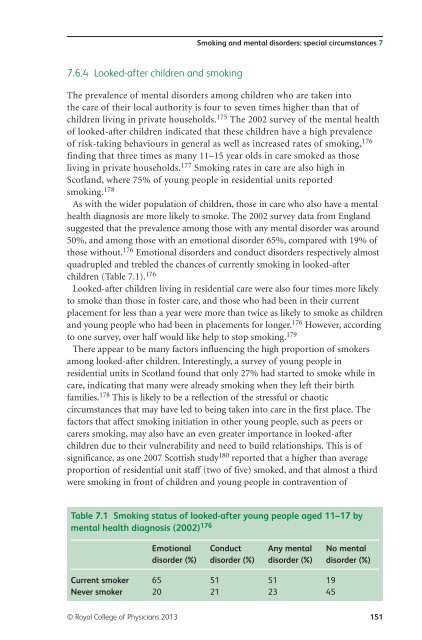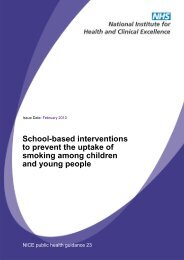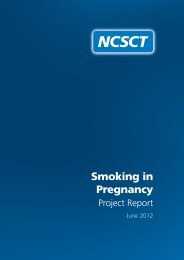Smoking and mental health - NCSCT
Smoking and mental health - NCSCT
Smoking and mental health - NCSCT
Create successful ePaper yourself
Turn your PDF publications into a flip-book with our unique Google optimized e-Paper software.
<strong>Smoking</strong> <strong>and</strong> <strong>mental</strong> disorders: special circumstances 7<br />
7.6.4 Looked-after children <strong>and</strong> smoking<br />
The prevalence of <strong>mental</strong> disorders among children who are taken into<br />
the care of their local authority is four to seven times higher than that of<br />
children living in private households. 175 The 2002 survey of the <strong>mental</strong> <strong>health</strong><br />
of looked-after children indicated that these children have a high prevalence<br />
of risk-taking behaviours in general as well as increased rates of smoking, 176<br />
finding that three times as many 11–15 year olds in care smoked as those<br />
living in private households. 177 <strong>Smoking</strong> rates in care are also high in<br />
Scotl<strong>and</strong>, where 75% of young people in residential units reported<br />
smoking. 178<br />
As with the wider population of children, those in care who also have a <strong>mental</strong><br />
<strong>health</strong> diagnosis are more likely to smoke. The 2002 survey data from Engl<strong>and</strong><br />
suggested that the prevalence among those with any <strong>mental</strong> disorder was around<br />
50%, <strong>and</strong> among those with an emotional disorder 65%, compared with 19% of<br />
those without. 176 Emotional disorders <strong>and</strong> conduct disorders respectively almost<br />
quadrupled <strong>and</strong> trebled the chances of currently smoking in looked-after<br />
children (Table 7.1). 176<br />
Looked-after children living in residential care were also four times more likely<br />
to smoke than those in foster care, <strong>and</strong> those who had been in their current<br />
placement for less than a year were more than twice as likely to smoke as children<br />
<strong>and</strong> young people who had been in placements for longer. 176 However, according<br />
to one survey, over half would like help to stop smoking. 179<br />
There appear to be many factors influencing the high proportion of smokers<br />
among looked-after children. Interestingly, a survey of young people in<br />
residential units in Scotl<strong>and</strong> found that only 27% had started to smoke while in<br />
care, indicating that many were already smoking when they left their birth<br />
families. 178 This is likely to be a reflection of the stressful or chaotic<br />
circumstances that may have led to being taken into care in the first place. The<br />
factors that affect smoking initiation in other young people, such as peers or<br />
carers smoking, may also have an even greater importance in looked-after<br />
children due to their vulnerability <strong>and</strong> need to build relationships. This is of<br />
significance, as one 2007 Scottish study 180 reported that a higher than average<br />
proportion of residential unit staff (two of five) smoked, <strong>and</strong> that almost a third<br />
were smoking in front of children <strong>and</strong> young people in contravention of<br />
Table 7.1 <strong>Smoking</strong> status of looked-after young people aged 11–17 by<br />
<strong>mental</strong> <strong>health</strong> diagnosis (2002) 176<br />
Emotional Conduct Any <strong>mental</strong> No <strong>mental</strong><br />
disorder (%) disorder (%) disorder (%) disorder (%)<br />
Current smoker 65 51 51 19<br />
Never smoker 20 21 23 45<br />
© Royal College of Physicians 2013 151














